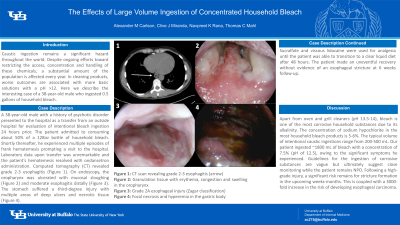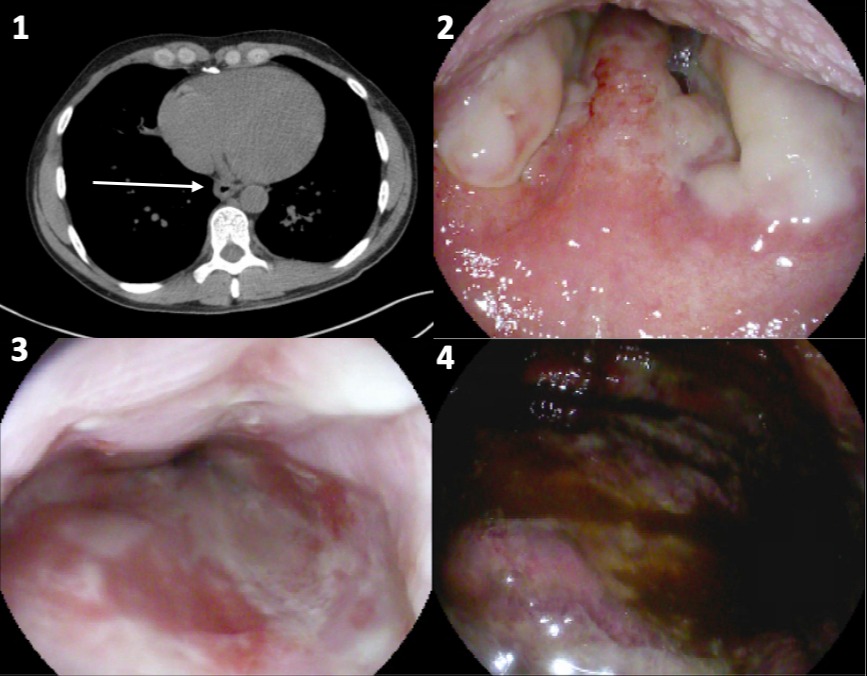Monday Poster Session
Category: General Endoscopy
P2009 - The Effects of Large Volume Ingestion of Concentrated Household Bleach
Monday, October 23, 2023
10:30 AM - 4:15 PM PT
Location: Exhibit Hall

Has Audio

Alexander M. Carlson, DO
University at Buffalo
Buffalo, NY
Presenting Author(s)
Alexander M. Carlson, DO1, Clive J. Miranda, DO, MS1, Navpreet K. Rana, DO, MS2, Thomas C. Mahl, MD1
1University at Buffalo, Buffalo, NY; 2University at Buffalo, Orchard Park, NY
Introduction: Caustic ingestion remains a significant hazard throughout the world. Despite ongoing efforts toward restricting the access, concentration and handling of these chemicals, a substantial amount of the population is affected every year. In cleaning products, worse outcomes are associated with more basic solutions with a pH >12. Here we describe the interesting case of a 38-year-old male who ingested 0.5 gallons of household bleach.
Case Description/Methods: A 38-year-old male with a history of psychotic disorder presented to the hospital as a transfer from an outside hospital for evaluation of intentional bleach ingestion 24 hours prior. The patient admitted to consuming about 50% of a 128oz bottle of household bleach. Shortly thereafter, he experienced multiple episodes of frank hematemesis prompting a visit to the hospital. Laboratory data upon transfer was unremarkable and the patient’s hematemesis resolved with ondansetron administration. Computed tomography (CT) revealed grade 2-3 esophagitis (Figure 1). On endoscopy, the oropharynx was ulcerated with mucosal sloughing (Figure 2) and moderate esophagitis distally (Figure 3). The stomach suffered a third-degree injury with multiple areas of deep ulcers and necrotic tissue (Figure 4). Sucralfate and viscous lidocaine were used for analgesia until the patient was able to transition to a clear liquid diet after 48 hours. The patient made an uneventful recovery without evidence of an esophageal stricture at 6 weeks follow-up.
Discussion: Apart from oven and grill cleaners (pH 13.5-14), bleach is one of the most corrosive household substances due to its alkalinity. The concentration of sodium hypochlorite in the most household bleach products is 5-6%. The typical volume of intentional caustic ingestions range from 200-500 mL. Our patient ingested ~1800 mL of bleach with a concentration of 7.5% (pH of 12.5), owing to the significant symptoms he experienced. Guidelines for the ingestion of corrosive substances are vague but ultimately suggest close monitoring while the patient remains NPO. Following a high-grade injury, a significant risk remains for stricture formation in the upcoming weeks-months. This is coupled with a 3000-fold increase in the risk of developing esophageal carcinoma.
In summary, this case illustrates the toxic effects of a large volume ingestion of household bleach that is not commonly encountered. Close attention towards evidence of perforation or airway compromise should be a pertinent consideration for every provider.

Disclosures:
Alexander M. Carlson, DO1, Clive J. Miranda, DO, MS1, Navpreet K. Rana, DO, MS2, Thomas C. Mahl, MD1. P2009 - The Effects of Large Volume Ingestion of Concentrated Household Bleach, ACG 2023 Annual Scientific Meeting Abstracts. Vancouver, BC, Canada: American College of Gastroenterology.
1University at Buffalo, Buffalo, NY; 2University at Buffalo, Orchard Park, NY
Introduction: Caustic ingestion remains a significant hazard throughout the world. Despite ongoing efforts toward restricting the access, concentration and handling of these chemicals, a substantial amount of the population is affected every year. In cleaning products, worse outcomes are associated with more basic solutions with a pH >12. Here we describe the interesting case of a 38-year-old male who ingested 0.5 gallons of household bleach.
Case Description/Methods: A 38-year-old male with a history of psychotic disorder presented to the hospital as a transfer from an outside hospital for evaluation of intentional bleach ingestion 24 hours prior. The patient admitted to consuming about 50% of a 128oz bottle of household bleach. Shortly thereafter, he experienced multiple episodes of frank hematemesis prompting a visit to the hospital. Laboratory data upon transfer was unremarkable and the patient’s hematemesis resolved with ondansetron administration. Computed tomography (CT) revealed grade 2-3 esophagitis (Figure 1). On endoscopy, the oropharynx was ulcerated with mucosal sloughing (Figure 2) and moderate esophagitis distally (Figure 3). The stomach suffered a third-degree injury with multiple areas of deep ulcers and necrotic tissue (Figure 4). Sucralfate and viscous lidocaine were used for analgesia until the patient was able to transition to a clear liquid diet after 48 hours. The patient made an uneventful recovery without evidence of an esophageal stricture at 6 weeks follow-up.
Discussion: Apart from oven and grill cleaners (pH 13.5-14), bleach is one of the most corrosive household substances due to its alkalinity. The concentration of sodium hypochlorite in the most household bleach products is 5-6%. The typical volume of intentional caustic ingestions range from 200-500 mL. Our patient ingested ~1800 mL of bleach with a concentration of 7.5% (pH of 12.5), owing to the significant symptoms he experienced. Guidelines for the ingestion of corrosive substances are vague but ultimately suggest close monitoring while the patient remains NPO. Following a high-grade injury, a significant risk remains for stricture formation in the upcoming weeks-months. This is coupled with a 3000-fold increase in the risk of developing esophageal carcinoma.
In summary, this case illustrates the toxic effects of a large volume ingestion of household bleach that is not commonly encountered. Close attention towards evidence of perforation or airway compromise should be a pertinent consideration for every provider.

Figure: Figure 1: CT scan revealing grade 2-3 esophagitis (arrow)
Figure 2: Granulation tissue with erythema, congestion and swelling in the oropharynx
Figure 3: Grade 2A esophageal injury (Zagar classification)
Figure 4: Focal necrosis and hyperemia in the gastric body
Figure 2: Granulation tissue with erythema, congestion and swelling in the oropharynx
Figure 3: Grade 2A esophageal injury (Zagar classification)
Figure 4: Focal necrosis and hyperemia in the gastric body
Disclosures:
Alexander Carlson indicated no relevant financial relationships.
Clive Miranda indicated no relevant financial relationships.
Navpreet Rana indicated no relevant financial relationships.
Thomas Mahl indicated no relevant financial relationships.
Alexander M. Carlson, DO1, Clive J. Miranda, DO, MS1, Navpreet K. Rana, DO, MS2, Thomas C. Mahl, MD1. P2009 - The Effects of Large Volume Ingestion of Concentrated Household Bleach, ACG 2023 Annual Scientific Meeting Abstracts. Vancouver, BC, Canada: American College of Gastroenterology.
